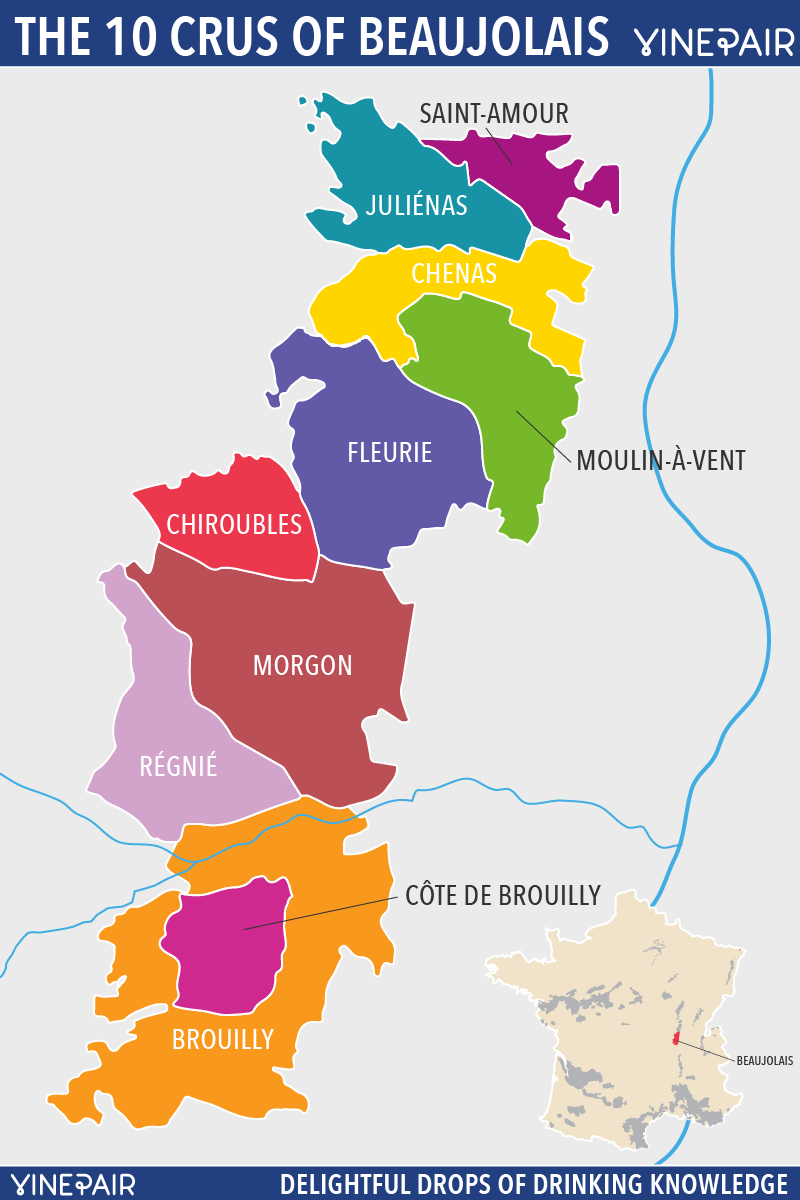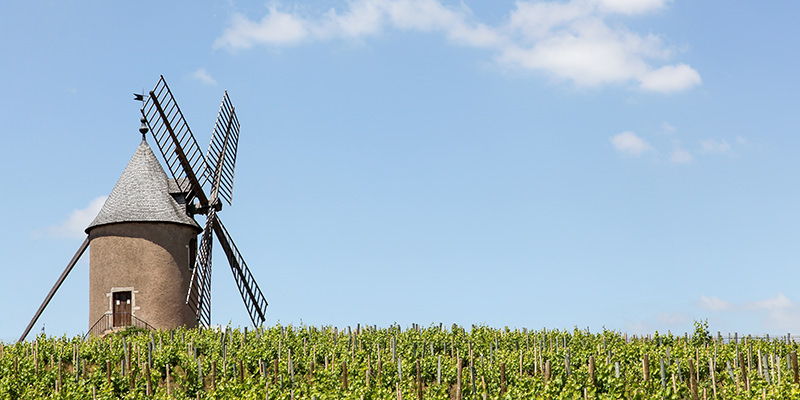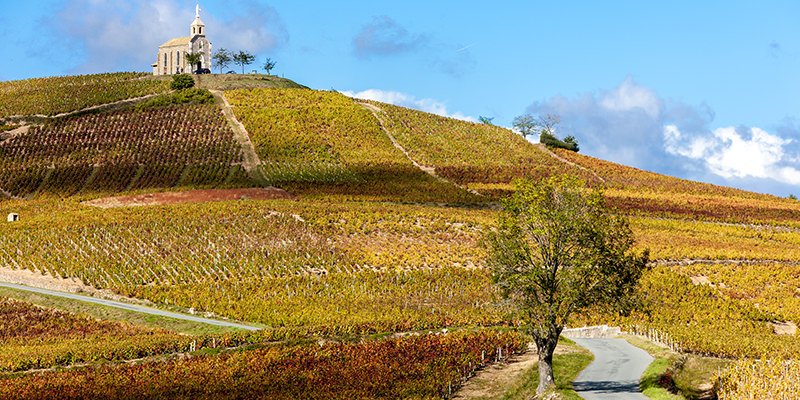Ask any sommelier which wines they’re kicking back with off the clock and it’s a safe bet that cru Beaujolais is on that list. Recently, the region of Beaujolais has begun to crawl out from under the poor reputation imposed on it by the Thanksgiving mainstay Beaujolais Nouveau. Rather than being represented by this lackluster, just-fermented juice, Beaujolais is becoming recognized once again as a source of lighter-bodied, easy-drinking reds made from the Gamay grape
This is largely thanks to ten named crus located in the northern part of Beaujolais, just south of Burgundy’s Macon region, where the best examples of Beaujolais are made. Wines produced in these crus (hence the term “cru Beaujolais”) are allowed to be labeled with the cru from which they hail, be it Morgon, Fleurie, Brouilly, etc. Those in the know see cru Beaujolais as a source for wines that are more robust, more structured, and more ageable than standard Beaujolais, but with all the friendliness and affordability that the overall region offers.
However, all crus are not equal, and each one has its own quirky personality and style of wines, making exploring the world of cru Beaujolais that much more fun! Which cru is right for you? This guide is a start, but the best – and most delicious – way to find out is to try them all for yourself.
Saint-Amour: “An Eye for Romance”
It may be cliché, but how can we not think of Saint-Amour as the most romantic of the Beaujolais crus? This light, easy-drinking cru is the most northerly of the ten, characterized by soft red fruit. Unsurprisingly, sales of Saint-Amour spike in February, right around Valentine’s Day, but the wine is delicious year-round. Saint-Amour also produces a more serious style of wine, due to variation in soils, so perhaps its two personalities can instead be thought of as those of a fickle lover.
Recommended: 2013 Domaine des Billards, Saint-Amour
Juliénas: “Strong-Rooted”
With a winemaking history that dates back 2000 years ago to the times of Julius Caesar (from whom the name of the cru comes), Juliénas’ character is rooted in the earth. Unfortunately, there aren’t very many high-quality producers in Juliénas, and styles of wine can vary quite a bit, but overall, the wines tend to be on the weightier side, with dark red fruit flavors and earthiness.
Recommended: Chateau Fuissé ‘Domaine de la Conseillere,’ Juliénas
Chénas: “Playing Hard-to-Get”
Are you up to a challenge? Try to hunt down a bottle of Chénas, the rarest cru in Beaujolais. Few examples are exported to the U.S., so the small Chénas often remains elusive, but the wines are worth the effort and easy to love. Sometimes quite Burgundian in style, Chénas is a sturdier cru and has a mineral intensity – like its neighbor Moulin-a-Vent – that develops with age.
Recommended: 2011 Paul-Henri Thillardon ‘Les Carrieres,’ Chénas

Moulin-à-Vent : “King of the Crus”
When it comes to body, ageability, and tannic structure, Moulin-à-Vent reigns above them all. The soils in Moulin-a-Vent cause the vines to yield fewer but more concentrated berries, creating a style of wine that couldn’t be further from the stereotypical fresh, easy-drinking style of Beaujolais lacking in complexity. Moulin-à-Vent is robust and (relatively) tannic, and while by no means are these wines unapproachable when young, they can also age for 10, 20, sometimes even 50 years, bearing similarities to Burgundy and Rhone wines as they get older.
Recommended: 2012 Christophe Pacalet, Moulin-à-Vent
Fleurie: “Pretty Pretty Princess”
While Fleurie may not have the power of the well-known crus of Moulin-a-Vent and Morgon, its charming, floral elegance makes just as much of a lasting impression. After these two crus, it is probably the most recognizable, as there are quite a few quality Fleurie producers exporting their wines to the U.S. A lighter style of cru Beaujolais, Fleurie is characterized by blossom-like red fruit and the unmistakeable aromas of les fleurs rose and violet. Undoubtedly the prettiest of the crus, Fleurie is excellent chilled.
Recommended: 2014 Yann Bertrand ‘Folie,’ Fleurie

Chiroubles: “The Gateway Cru”
For those who are used to drinking standard Beaujolais or even Beaujolais Nouveau, Chiroubles is a great wine to transition into the world of cru Beaujolais. This isn’t to say that Chiroubles is of lesser quality than the other crus; rather, it speaks to the fact that Chiroubles is the lightest bodied cru Beaujolais. This is because Chiroubles has the highest elevation in the region, and therefore, the coolest temperatures, creating delicate red berry fruit and similar violet note to its neighbor, Fleurie. But be forewarned – once you dive into Chiroubles, you’ll never want to get out of the cru Beaujolais pool.
Recommended: 2011 Domaine des Marrans Vieilles Vignes, Chiroubles
Morgon: “The Bold Scholar”
Second only to Moulin-a-Vent in terms of body and structure, Morgon is another fuller-bodied, more serious cru. Fortunately, it is also the second largest Beaujolais cru, with a concentration of high-quality producers, so it’s one of the most prevalent crus in the U.S. While granite – Gamay’s favorite soil to dig down into – is prevalent throughout the crus of Beaujolais, Morgon is especially granite-centric, creating concentrated, serious, and fairly tannic wines. Morgon is comprised of six named vineyards, the most famous of which is Cote du Py, and all of these wines get better – and much more interesting – with age.
Recommended: 2014 Marcel Lapierre, Morgon
Régnié: “New Kid on the Block”
Who’s that cool new kid with just the right amount of funk to get everyone talking? Oh, it’s Régnié! Elevated in 1988, Régnié is the youngest of the Beaujolais crus, and stylistically, it brings together the fresh fruit of Brouilly with a bit of the body and structure of Morgon. It’s supple but lively, with bright raspberry flavors and often a spicy note that makes it distinctive. Lace up your freshest kicks and drink this guy young!
Recommended: 2014 Julien Sunier, Régnié
Côte de Brouilly: “The Older Brother”
Côte means hillside in French, but the Côte de Brouilly isn’t actually a hillside at all – it’s an ancient volcano. Vines are grown on the ancient volcano’s slopes, where they get more sun and better drainage than the surrounding plains of Brouilly. This creates wines that are a bit riper, more serious, and more ageable than little brother Brouilly. Don’t hesitate to invite Côte de Brouilly to the party, though; he’s friendly and fresh, too!
Recommended: 2014 Laurence & Remi Dufaitre, Côte de Brouilly
Brouilly: “Crowd Pleaser”
The largest and most southerly cru of Beaujolais is like that friend that you want to invite to every party – he’s friendly, starts up conversation easily, and isn’t one to stir up drama. Brouilly is the wine to have on hand for any occasion because somehow, it always fits and is easy to find; there’s a reason why it’s the table wine of many a bistro in France. Light to medium bodied, it is typically lively, fruity, and fresh.
Recommended: 2012 Chateau de la Chaize, Brouilly

